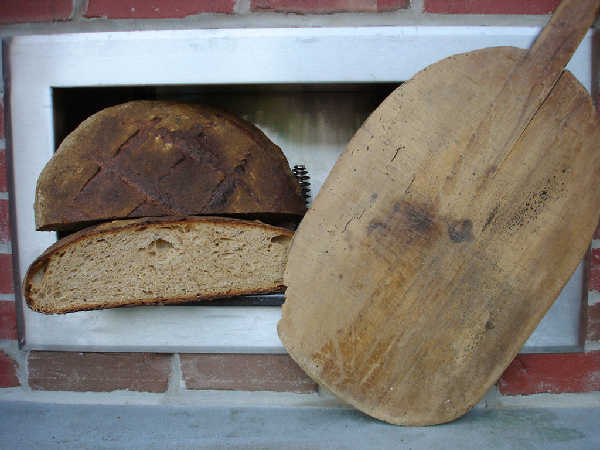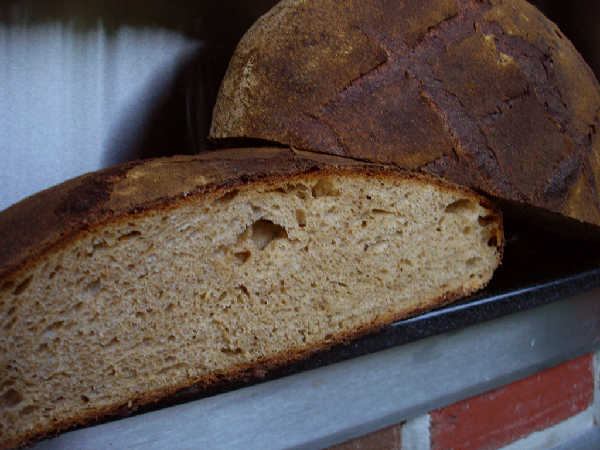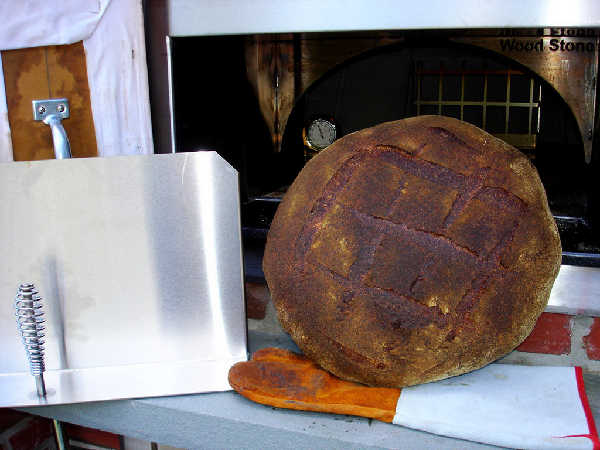


This miche is a lower hydration version of Miche(2) blogged a while back. I accidentally mixed in an entire levain that had been made larger than what I had intended in this recipe originally. I wanted to have an inoculation or percentage of fermented flour to total flour of 15%, similar to Hamelman's VT Sourdough, but I ended up with about 22%. I therefore had a problem with excess acid breaking down the gluten, which made the boule hard to shape and ended up making this a slightly denser miche than I've accomplished before. It's still a good chunk of bread. I baked it in my new brick oven from Woodstone. I managed to get the temperature much more reasonable, and came out with a nice crust and avoided the scorching I'd had in the first few attempts with this new oven, as I learned to manage the heat and the steam in a brick oven.
I have some photos of the process and an html spreadsheet, as well as the Excel spreadsheet that includes the recipe and a model to estimate the bulk fermentation and final proof times.
Miche(3) Recipe
Levain
- 15g 90% hydration white flour storage starter (use any storage starter)
- 90g Wheat Montana AP (or any other strong white flour)
- 105g whole spelt
- 89g Golden Buffalo from Heartland Mills (Use any high extraction wheat flour or substitute white flour here)
- 145g water
- 81g whole rye
- 54g whle spelt
- 108g Wheat Montana Bronze Chief (or other red whole wheat flour)
- 338g Golden Buffalo from Heartland Mills (or other high extraction red wheat flour)
- 257g Sifted White Wheat Flour from Homestead Grist Mill (or other high extraction white wheat flour)
- 680g water
- 12g malt syrup
- Levain from above
- Soak from above
- 219g Wheat Montana AP (or other strong white flour)
- 139g water
- 26g salt
The night before you plan to bake, mix the levain ingredients, knead minimally, and let it rise overnight, preferably until it has somewhat more than doubled but not much more, about 10 hours. You can also mix it earlier in the day, let it rise by double and refrigerate it. Also mix the soak ingredients, knead minimally just to mix the ingredients, the water, and the malt syrup. Refrigerate the soak overnight.
Mix and Knead Dough
Mix the additional white flour and water and knead minimally into a small dough. Spread the soak out like a pizza. Spread the white flour over the soak, roll up, and knead lightly to mix. Spread the dough out again and spread the levain over the dough, roll up, and knead the dough until well mixed. I have used a technique described by Glezer in Artisan Baking that works very well to mix the dough. It involves working down the dough squeezing it and extruding it through the fingers. I repeatedly dampen my hands to avoid too much sticking. Alternately, I work in some folds similar to a kneading technique in Bertinet's video and also described by Glezer in Artisan Baking.
Let the dough rest for about 30 minutes.
Spread the dough out like a pizza and sprinkle the salt over it. Again, knead to thoroughly mix the salt and to get a soft but not wet dough that is smooth and has some initial gluten development.
Bulk Fermentation
Cover the dough and set aside to rise. Stretch and fold every 30-40 minutes. The total time from mixing the levain in with the dough would be about 3-3.5 hours using my starter. It should somewhat less than double in volume during that time.
Shaping
Shape into a boule and allow it to sit on the counter upright for 10 minutes to allow the seams to seal. Be sure to shape tightly, or you will get large holes or crust separation on the sides or on top. Place upside down in a banneton or a bowl lined with a well dusted cloth. This dough can be sticky, especially if it gets too wet, so beware of sticking couche fabric. Adding about 25% rice flour to the dusting flour may help with this.
Final Proof
The final proof would normally take 2-2.5 hours with my starter. I normally place the whole thing in a ziplog "Big Bag" along with a bowl of warm water to maintain a warm and humid environment for the final proof.
Bake
Turn the loaf onto a peel dusted with semolina or corn meal. Slash as you like. I wasn't paying too much attention to this one, and ended up making a "square" pattern, which is not too attractive in retrospect. I liked a "diamond" pattern I had done previously, which is what this one was supposed to be.
Bake starting at 450F with steam, however you may accomplish that. Drop the temperature in the oven down to 400F, then down to 350F, if necessary, if the crust begins to get too dark. Bake for about 45-70 minutes, depending on your objectives. I did this one for 70 minutes to get a fairly dry crumb and a crisp crust that stays that way. However, sometimes I bake for less time, so I can freeze the bread and then reheat it later. I think it is better reheated or toasted if it hasn't been fully baked at bake time.
Cool
Allow to fully cool.
Results
I'm still very happy with the flavor, which is very similar to miche(2). This time, the lower hydration resulted in a slightly denser crumb, but it is more practical for sandwiches or for toast in the morning. The crust stays crisp with the long bake and lower hydration, which I had trouble with in miche(2). Unfortunately, I think the crumb would have been better and the rise and density better if I had used a lower inoculation, like 15%, and a slightly less ripe levain. That will be the adjustment for next time.
No comments:
Post a Comment
Note: Only a member of this blog may post a comment.